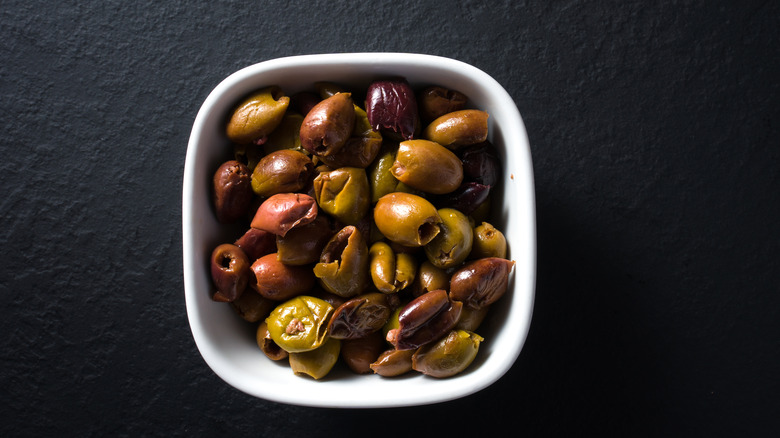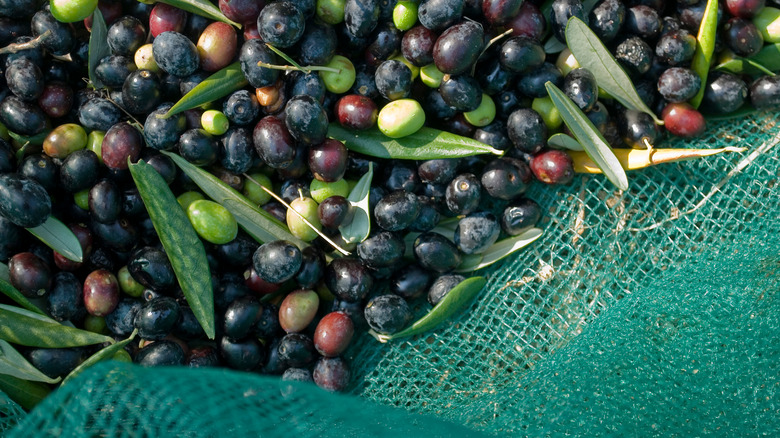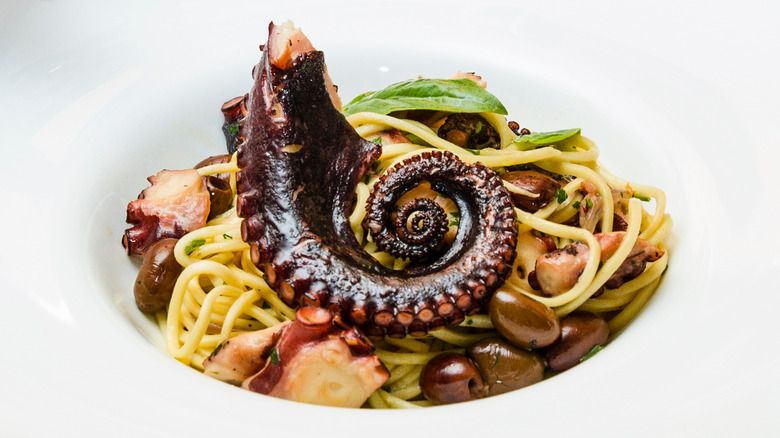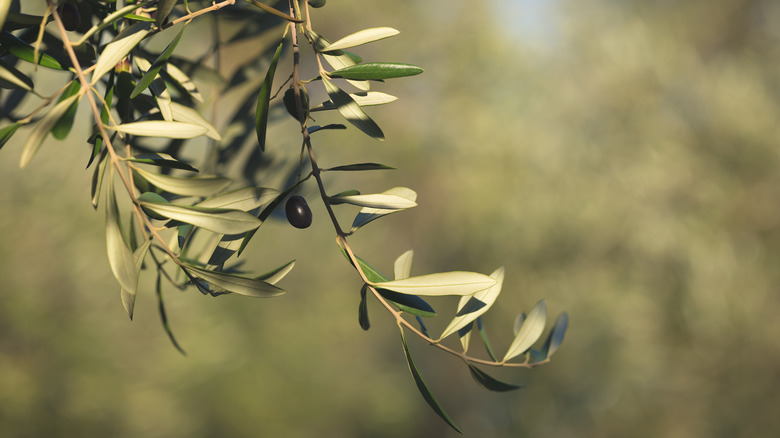What Makes Taggiasca Olives Unique
Olives are integral to the Italian diet. Eaten as a snack during aperitivo or pressed into oil and used as the base of any dish, to say olives are important is an understatement. That said, while southern varieties like the buttery Castelvetrano or tart Gaeta are often in the culinary limelight, there's another cultivar that's known as northwestern Italy's sweetheart: the Taggiasca.
Technically speaking, Olive Oil Emporium explains that Italian Taggiasca olives are part of the Cailletier cultivar, just like French Niçoise olives. Beyond a slight difference in terroir, Niçoise olives describe fruit that's already undergone a salt-brining process. In contrast, Taggiasca olives refer to the actual cultivar.
Named after the town of Taggia, Organic Farming Italy reports that the olives are said to have been introduced to the area by French Benedictine monks in the 7th century. Moving inland from the Côte d'Azur and founding a new monastery, locals consider the monks responsible for planting the first Taggiasca trees. Thriving thanks to the coastal climate and calcium-rich soils, the plump yet petite olives have since become a sensation, defining Ligurian cuisine — but more on that later.
Processing olive taggiasche
Trailing up twisted trunks, Taggiasca trees have an abundance of branches, each rich with foliage and fruit. Budding as bitter green berries, Olio Abbo explains that the small olives (roughly 1/2 an inch) are usually harvested once they've darkened to a brownish green or brownish burgundy.
Due to the rugged and hilly landscape, Taggiasca olives must be exclusively harvested by hand, a process that can take several weeks. Foodiletto outlines that traditionally, mesh netting is laid under the plants to catch any fallen fruit before laborers shake the rest loose from branches with a wooden stick called a trappa. However, modern amenities like vibrating machines can also help speed the process along.
Once harvested, the olives are cleaned and ready to be cold-pressed into oil or cured, which is necessary as freshly-picked drupes are super bitter. Smashing olives with a hammer for better liquid absorption — although they can also be left whole in the case of thin-skinned Taggiasca — Fidelity Cucina shares that the olives are immersed in a saltwater brine for several weeks, changing the brine every few days. After this brining process is over, Frantoi San Martino explains that olives can be drained and left to ferment for several months in a less salty brine, dried and packed into salt, or added to oil with aromatics like rosemary, thyme, and bay leaves (via Olio Ardissone).
An ultra unique flavor profile
Small but mighty, Taggiasche are full of flavor. Especially meaty for their size, the firm fruits are deeply aromatic and incredibly fruity, according to Olio Roi. Sweeter than other cultivars, the Taggiasca variety fares well in an array of dishes. Left whole or blended into a rich and briny tapenade, the olives are a great match for pillowy focaccia, mild semi-soft cheeses, and fresh vegetable salads. Naturally, True Italian shares that the olives also steal the show in traditional Ligurian recipes such as braised rabbit, stewed sauces, and of course, seafood dishes — roasted branzino, anyone?
Alternatively, when pressed into oil, Gambero Rosso explains that the straw-colored oil maintains its fruitiness while also displaying hints of delicate spice, salt, and nuances of almond and artichoke. Light and subtle, the olive oil is an obvious choice when drizzled over local produce or, better yet, when added as a base for locally-made pesto.
Although it's definitely worth seeking out Taggiasca olives at a specialty store or through an online retailer, if you can't seem to track them down, Eataly recommends exploring northern cultivars like the herbaceous Razzola olive or fruity Pignola. In a pinch, Italian Food Forever also suggests substituting Taggiasca with an equally flavorful and fruity black olive like a Greek Kalamata; however, they might a punchier flavor as a result of being brined in wine vinegar.
Taggiasche are one of a kind
Regardless of the cultivar, Healthline shares that olives are rich in vitamin E and antioxidants, which can contribute to lowering cholesterol and blood pressure. They also contain anti-inflammatory compounds called polyphenols. Despite the fact that The Art of Eating shares that Ligurian (and even Provençal) varieties aren't as high in polyphenols as other olives, that isn't to say that Taggiasche don't have their fair share of good qualities.
When it comes to oil production, Olio Alberti reports that the Taggiasca is praised for its ability to yield more liquid gold — up to 26% more — in comparison to other northern cultivars in Liguria. This is why it's a key player in the production of DOP-certified Riviera Ligure Extra Virgin Olive Oil. That said, though there are many types of Italian olives used to craft oil, only a few varietals are worthy of also being enjoyed tableside.
Different from larger snacking and oil-producing varieties like the sweet Nocellara del Belice or earthy Itrana olive, the tiny Taggiasca boasts an impressively unexpected level of complexity that's both mildly fruity with a twang of zest. Try them for yourself and taste the difference!



